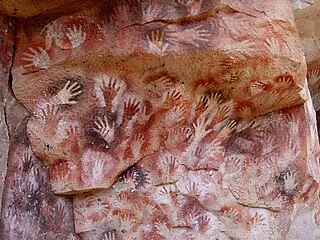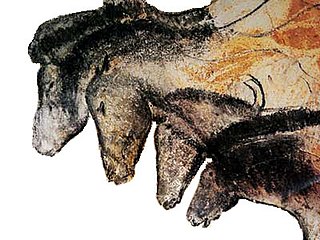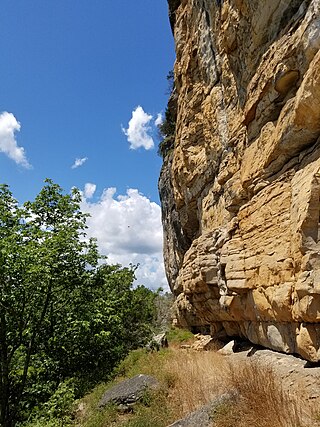Related Research Articles

Vallon-Pont-d'Arc is a village in southern France in the Ardèche Department.

The Chickasaw are an Indigenous people of the Southeastern Woodlands, United States. Their traditional territory was in northern Mississippi, northwestern and northern Alabama, western Tennessee and southwestern Kentucky. Their language is classified as a member of the Muskogean language family. In the present day, they are organized as the federally recognized Chickasaw Nation.

In archaeology, cave paintings are a type of parietal art, found on the wall or ceilings of caves. The term usually implies prehistoric origin. These paintings were often created by Homo sapiens, but also Denisovans and Neanderthals; other species in the same Homo genus. Discussion around prehistoric art is important in understanding the history of the Homo sapiens species and how Homo sapiens have come to have unique abstract thoughts. Some point to these prehistoric paintings as possible examples of creativity, spirituality, and sentimental thinking in prehistoric humans.

The Chauvet-Pont-d'Arc Cave in the Ardèche department of southeastern France is a cave that contains some of the best-preserved figurative cave paintings in the world, as well as other evidence of Upper Paleolithic life. It is located near the commune of Vallon-Pont-d'Arc on a limestone cliff above the former bed of the river Ardèche, in the Gorges de l'Ardèche.

In archaeology, rock arts are human-made markings placed on natural surfaces, typically vertical stone surfaces. A high proportion of surviving historic and prehistoric rock art is found in caves or partly enclosed rock shelters; this type also may be called cave art or parietal art. A global phenomenon, rock art is found in many culturally diverse regions of the world. It has been produced in many contexts throughout human history. In terms of technique, the four main groups are:

Dunbar Cave State Park is a 110 acre protected area in Clarksville, Tennessee. Dunbar Cave is the 280th largest cave complex in the world, stretching 8.067 miles (13 km) inward. The cave is located in an area of karst topography, including sinkholes, springs, and limestone bedrock. In front of the cave entrance is a large concrete poured structure with three distinct arches and the manmade Swan Lake. In March 2010 the cave was temporarily closed to tours and visitors because a bat infected with White nose syndrome was found in the cave.

Moundville Archaeological Site, also known as the Moundville Archaeological Park, is a Mississippian culture archaeological site on the Black Warrior River in Hale County, near the modern city of Tuscaloosa, Alabama. Extensive archaeological investigation has shown that the site was the political and ceremonial center of a regionally organized Mississippian culture chiefdom polity between the 11th and 16th centuries. The archaeological park portion of the site is administered by the University of Alabama Museums and encompasses 185 acres (75 ha), consisting of 29 platform mounds around a rectangular plaza.
Patty Jo Watson was an American archaeologist noted for her work on Pre-Columbian Native Americans, especially in the Mammoth Cave region of Kentucky. Her early investigations focused on the origins of agriculture and pastoralism in the Near East. Watson's contributions to the field of archaeology, particularly her work in the American Southeast, have left a lasting impact on the understanding of ancient human societies.

Pech Merle is a French hillside cave at Cabrerets, in the Lot département of the Occitania region, about 32 kilometres east of Cahors, by road. It is one of the few prehistoric cave painting sites in France that remains open to the general public, albeit with an entry fee. Encompassing two levels and spanning over 2 km in area—of which only 1,200 m (3,900 ft) are open to the public—are caverns, wells and sloping tunnels, the walls of which are painted with dramatic, prehistoric murals dating from the Gravettian culture. But some of the paintings and engravings may date from the later Magdalenian era.

Oxtotitlán is a natural rock shelter and archaeological site in Chilapa de Álvarez, Mexican state of Guerrero that contains murals linked to the Olmec motifs and iconography. Along with the nearby Juxtlahuaca cave, the Oxtotitlán rock paintings represent the "earliest sophisticated painted art known in Mesoamerica", thus far. Unlike Juxtlahuaca, however, the Oxtotitlán paintings are not deep in a cave system but rather occupy two shallow grottos on a cliff face.
Stephen Alvarez is an American photojournalist. He is founder and president of the Ancient Art Archive, a global initiative to record, preserve, and share high-resolution images of ancient artwork. Throughout his career, he has produced global stories about exploration and culture. He became a National Geographic photographer in 1995. His pictures have won awards in Pictures of the Year International and Communications Arts and have been exhibited at Visa Pour L’Image International Photojournalism Festival in Perpignan, France.
Jan F. Simek is an American archaeologist and educator who was the interim president of the University of Tennessee system from 2009 to 2010.

The Castalian Springs Mound State Historic Site (40SU14) is a Mississippian culture archaeological site located near the small unincorporated community of Castalian Springs in Sumner County, Tennessee. The site was first excavated in the 1890s and again as recently as the 2005 to 2011 archaeological field school led by Dr. Kevin E. Smith. A number of important finds have been associated with the site, most particularly several examples of Mississippian stone statuary and the Castalian Springs shell gorget held by the National Museum of the American Indian. The site is owned by the State of Tennessee and is a State Historic Site managed by the Bledsoe's Lick Association for the Tennessee Historical Commission. The site is not currently open to the public.

Rock art has been produced in Europe since the Upper Palaeolithic period through to recent centuries. It is found in all of the major regions of the continent. One of the most famous examples of parietal art is the Grotte Chauvet in France. The cultural purpose of these remnants of the Paleolithic and other periods of prehistoric art is not known. However, some theories suggest that, because these paintings were created in parts of the caves that were not easily accessed, it is unlikely that they were intended simply as decoration.
Manitou Cave is a cave in Alabama, near the town of Fort Payne, in the side of Lookout Mountain. In the early 1800s, the Fort Payne area was a Cherokee settlement named Willstown. This was the home of Sequoyah during his time of creating the Cherokee syllabary. Later, Sequoyah's son wrote on the walls of Manitou Cave using this syllabary, documenting ceremonial events and other culturally significant information and history. In the 1830s, Cherokee people were forcibly relocated from this area along the Trail of Tears, leaving the cave empty for some time. During the Civil War, the cave was a source of saltpeter for the Confederate Army. The mineral was mined by laborers to provide the essential ingredient for black powder. The cave was also designated fallout shelter during the Cold War.

Coliboaia Cave is located in Apuseni Natural Park, Câmpani, Bihor County, Romania. It may contain the oldest known cave paintings of Central Europe, radiocarbon dated to 32,000 and 35,000 years BP, corresponding to the Aurignacian and Gravettian cultures of the Paleolithic period.
Dominique Baffier is a French archaeologist and prehistorian who specialises in paleolithic cave paintings, or parietal art. She is known for her work at the Arcy-sur-Cure cave complex and for her subsequent role as curator of the Chauvet Cave from 2000 to 2014.
This page lists major events of 2019 in archaeology.

Painted Bluff is a cliff overlooking the Tennessee River in Marshall County, Alabama that features over 130 individual prehistoric Native American pictographs and petroglyphs. Painted Bluff is located about 4 miles (6.4 km) downstream from the Guntersville Dam and is only accessible by boat. The bluff is divided into three levels: the low ledge along the river, a middle ledge above it, and a high ledge near the top of the cliff face. A small cave is located along the low ledge.
References
- 1 2 "The Writing on the Wall". National Parks Conservation Association. Retrieved 2024-02-28.
- 1 2 "Origins of Art". web.archive.org. 2019-08-05. Retrieved 2024-02-28.
- ↑ "Ancient Silk Road Art Faces Risks From Climate Change in China". Bloomberg.com. 2023-07-17. Retrieved 2024-02-28.
- 1 2 Varagur, Krithika (2020-02-21). "World's oldest art under threat from cement mining in Indonesia". The Guardian. ISSN 0261-3077 . Retrieved 2024-02-28.
- ↑ Rachwani, Mostafa (2022-12-21). "Ancient Aboriginal rock art destroyed by vandals in 'tragic loss' at sacred SA site". The Guardian. ISSN 0261-3077 . Retrieved 2024-02-28.
- ↑ "Mural of America Project Virtual Program". Explore Oak Ridge. Retrieved 2024-02-28.
- 1 2 Strickland, Ashley (2022-05-04). "Unexpected discovery of mysterious drawings could change the way scientists look at cave art". CNN. Retrieved 2024-02-28.
- ↑ Mintz, Donna (June 23, 2017). "Humanity's Oldest Stories, Told in the First Person: Photographer Stephen Alvarez's Ancient Art Archive". ArtsAtl.
- ↑ "Messages from Across the Millennia". The University of the South. Retrieved 2024-02-28.
- ↑ "Alan M Cressler | U.S. Geological Survey". www.usgs.gov. Retrieved 2024-02-28.
- 1 2 3 4 Hauser, Christine (May 7, 2022). "In Alabama's '19th Unnamed Cave,' a Trove of Ancient Dark-Zone Art". New York Times.
- ↑ "Unnamed Caves". Vol. Spring 2011, no. 196. 2011. ISSN 0031-2037 . Retrieved 2024-02-28.
- 1 2 Joosse, Tess (May 4, 2022). "Largest Native American cave art revealed by 3D scans". Science.
- ↑ Yang, Maya (2022-05-05). "Largest US cave figures, about 1,000 years old, discovered in Alabama". The Guardian. ISSN 0261-3077 . Retrieved 2024-02-28.
- ↑ Mattei, Shanti Escalante-De (2022-05-04). "The Largest Cave Drawings in North America Have Been Found in Alabama". ARTnews.com. Retrieved 2024-02-28.
- ↑ "In a secret Alabama cave, 1,000-year-old carvings thought to be largest discovered in U.S." NBC News. 2022-05-04. Retrieved 2024-02-28.
- ↑ Snider, Mike. "Scientists use 3D technology to uncover largest collection of ancient Native American cave art". USA TODAY. Retrieved 2024-02-28.
- ↑ "3D scans reveal largest cave art in North America". History. 2024-02-28. Retrieved 2024-02-28.
- ↑ Magazine, Smithsonian; Gannon, Megan. "3-D Scans Reveal Gigantic Native American Cave Art in Alabama". Smithsonian Magazine. Retrieved 2024-02-28.
- ↑ "Joe Watkins". The Montgomery Fellows. 2021-09-14. Retrieved 2024-02-28.
- ↑ "James Cawley | Director, Writer, Producer". IMDb. Retrieved 2024-02-28.
- ↑ Leatherbury, Jessika (2023-10-27). "Bridging Millennia: The Fusion of Art and Technology in Cultural Preservation". Grow Ada. Retrieved 2024-02-28.
- ↑ "Echoes of art reverberate through the Curb Center's latest exhibition". September 8, 2023.
- ↑ Alvarez, Stephen (2024-02-20). "National Geographic Storytellers Summit 2024 » Ancient Art Archive". Ancient Art Archive. Retrieved 2024-02-28.